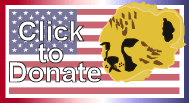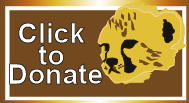Friday, 27 April 2012
Tigerlily's First Medical Checkup
She was also treated for a recent growth on her right front leg. Based on appearance, the growth could be a benign nerve tumour or an abscess. The mass was removed and skin closed and we will await the lab results from Idexx in South Africa. She then received prophylactic antibiotics and pain medication. Tigerlily recovered well and was soon back in her pen with her three siblings. Her sister Senay was anaesthetized the following day, while brothers Peter and Kaijay had their procedure a few days later. Everyone is doing great.
Below are some photos during and after Tigerlily's workup and one of the four siblings enjoying a beautiful day at CCF.
Rosie Glazier, DVN
Veterinary Nurse
Wednesday, 25 April 2012
First Kangal puppy litter placed!
Swing Gates to Reduce Human-Cheetah Conflict
On many farms across the world, fences protect animals inside their borders whilst keeping predators out. At CCF however, we also have the reverse situation: during a cheetah release in our Bellebenno game farm, we would like to keep the cheetahs inside the camp. In a normal game-fenced area, cheetahs and other predators can move freely through a fenced-in area using the holes that ground-digging species like warthogs, porcupines and aardvarks make under the fence. When farmers find cheetahs inside their game or livestock camps, they could run the risk of being trapped or shot as they may prey on their animals. Therefore, we have developed and are currently testing a non-lethal predator control system: swing gates. These are comparable to cat flaps, where digging species can range freely between farms without digging holes, whilst, when closed, they leave no visible opening for predators to move through. While researching the effectiveness of our swing gate system, camera traps have confirmed that the gates are used by different digging animals, but rarely, if ever, used by predators.
Our swing gates have considerably lowered the number of holes dug along the fence line, greatly reducing the amount of predators moving in and out of the camp, whilst keeping the cheetahs in the release area! Research is currently being conducted to determine which environmental factors influence the creation of holes between the gates from animals such as warthogs.
Swing gates provide farmers with an affordable alternative to the most conventional and expensive predator protection, i.e. fence electrification, which is good news for cheetahs! If the usage of non-lethal predator controls like swing gates becomes more common, this will reduce the chance of cheetahs and other predators getting into enclosures with valuable animals inside, which may decrease the human-wildlife conflict and subsequent killing of threatened animals such as the cheetah. So indirectly, the use of swing gates has the potential to increase the cheetah’s chances of survival!
Joël Kasser
CCF Ecology Intern
Photos (c) Cheetah Conservation Fund 2012
Tuesday, 24 April 2012
Cheetah Annual Examinations 2012
As in past years, the CCF team did annual health examinations on CCF’s resident cheetahs this month. The cheetahs were brought to the clinic individually for various sample collections, for example, blood, vaginal swabs, semen for sperm study and preservation. These samples will be analysed to assess the current health of all our captive cheetahs and any abnormality can be picked up and treated accordingly. Vaccinations and parasite treatments were also done to maintain good health. All the procedures went well and all cheetahs are in good health. We will be posting updates on some individual cheetahs.
We have included some photos showing the team listening to the cheetah’s heart and lungs; veterinarian Gabriella Flacke performing kidney ultrasound; dental assessment of crowded lower incisors; and sperm freezing in process.
Thank you
Rosie Glazier, DVN
Veterinary Nurse
Wednesday, 18 April 2012
Update from the Ecology Department
Thursday, 22 March 2012
Come to Paradise Wildlife Park (Browbourne) - Sat 31st March 2012.
The NamibRand Lady Cheetah is Back in Touch!
I didn't expect to hear anything further from this cheetah, or to be able to make any more updates, however the situation has changed again. I've been able to re-establish contact with the satellite collar and hope that this will be the first of many more weekly updates.
Since it has been a little while since the last report, I am including data for the whole of March and have also attached two maps (a close-up, and a more general area map showing where she is in relation to the NamibRand Reserve and Namib-Naukluft National Park.
For the past several weeks the female appears to have been operating exclusively on the farm of Lahnstein and has been sticking to the river valley in the south of the property. Our most recent data point, recorded at 03:36 this morning, places her 58 km NE of the NamibRand Reserve, 55 km NW of Maltahohe, 41 km SE of the Namib-Naukluft border, and 1.5 km N of the Lahnstein border with Kamkas.
Rob
Sunday, 18 March 2012
Amani's Annual Health Exam
On 7 March, Amani the cheetah had her annual exam performed as well as having some extensive dental work due to several broken teeth. She had a root canal performed on two canine (fang) teeth, and one premolar tooth. Performing root canals instead of extracting these damaged teeth will allow Amani to continue to tear, hold, and chew the meat she is fed without problems. Amani was also found to have a lesion on the cornea (surface) of the right eye. A corneal lesion is generally caused by trauma, for example walking into something and getting a scratch on the eye, or a piece of grass or sand that gets into the eye and scratches the surface. Infectious conditions can also cause eye ulcers in cats, including Herpes virus and several different bacteria. Amani’s corneal lesion will be treated with daily eye drops and monitoring closely. She is also receiving several days of anti-inflammatory pain medication and antibiotics due to her root canals. Otherwise Amani was in good condition and all parameters on her annual exam were within normal limits. She recovered well from her procedures and was back to eating meat pieces by the next morning.
Gaby
Saturday, 17 March 2012
Puppy Blog Udpate
Kiri’s puppies are growing up fast! They are now six weeks old, and received their first vaccination against distemper virus, parvovirus, adenovirus and parainfluenza this morning. The vaccine is a combination of all four diseases, and each puppy will receive a series of three of these vaccines at 6, 9, and 12 weeks of age. When they are 12 weeks old they will also receive their rabies vaccinations.
All the puppies were well-behaved and hardly noticed their vaccines being given. They are happy and healthy and cute as can be!
Gaby
Sunday, 11 March 2012
Safaris, Cheetahs, Africa – The Best Way Is to Show ‘Em
Safaris, Cheetahs, Africa – The Best Way Is to Show ‘Em
BY ALAN FELDSTEIN
In 2000 I made my first trip to Africa. It was during that safari I fell in love with Africa and everything about it – the people and their culture, the animals, the natural beauty of the landscape. The first time a giraffe bent her graceful neck to peer into my safari vehicle – well, she had me at jambo (Swahili for hello). All I had to do was see it for myself.
When I came back I told anyone that would listen how amazing Africa was and that they had to go – tomorrow, if not sooner. Most would nod and say – yeah sure…someday. I would reply you have to see it for yourself.
But I could not shake my passion so I went back to Africa. Again, and again and again. Finally I took my son and daughter on their first African safari On that trip, I got the chance to combine a wildlife safari with my other passion – kayaking. I had become friends with our safari organizer, Steve Chumbley, on a previous African visit and discovered we shared a love of kayaking. So, during this trip, the two of us set off exploring in kayaks Steve had built himself. Launching off the coast of Tanzania, we explored remote areas no other kayakers had ever been. But even that was not enough for me. So, enlisting Steve as my Tanzania-based business partner, I decided to start a safari company – Infinite Safari Adventures. Now, when people tell me they want to go to Africa “someday,” I can tell them “Someday is Now!” And help them see it for themselves.
Seeing is believing. I will never forget taking my kids to pet gray whales in Baja Mexico. After the long bus and vehicle travel from Tijuana to Baja, they were, to put it mildly, not happy. But all the whining, complaining and texting to friends was forgotten when we first set out on the water motorboat. Within, 10 minutes, a gray whale appeared close enough to our little motorboat to touch (and kiss). The next thing I heard was that this was the most awesome trip they had ever been on. After witnessing a mother whale and her babies playing, you will do anything in your power to save the whales. My son is now pursuing his degree in environmental education. All he had to do was see it for himself.
 |
| Petting a grey whale with my son in Baja. |
 |
| With Laurie and my dog Heidi who became a fast friend to her. |
If you are reading this blog item you are most likely a fan of CCF. But no matter how big a fan you are you have to see it for yourself.
That is one of the things that make me most passionate about Infinite Safari Adventures. Taking people on safari to see wildlife, meet the local people and experience all there is to see and do is the start of “paying it forward.” One person becomes inspired, who inspires others, who inspires still others and eventually there are enough inspired people that cheetahs, whales, rhinos, elephants and yes, even lions whose populations have been decimated will have a chance to live on for future generations. All you have to do is see it for yourself. Want to know how? Just ask me.
Alan Feldstein
Infinite Safari Adventures
www.infinitesafariadventures.com



























